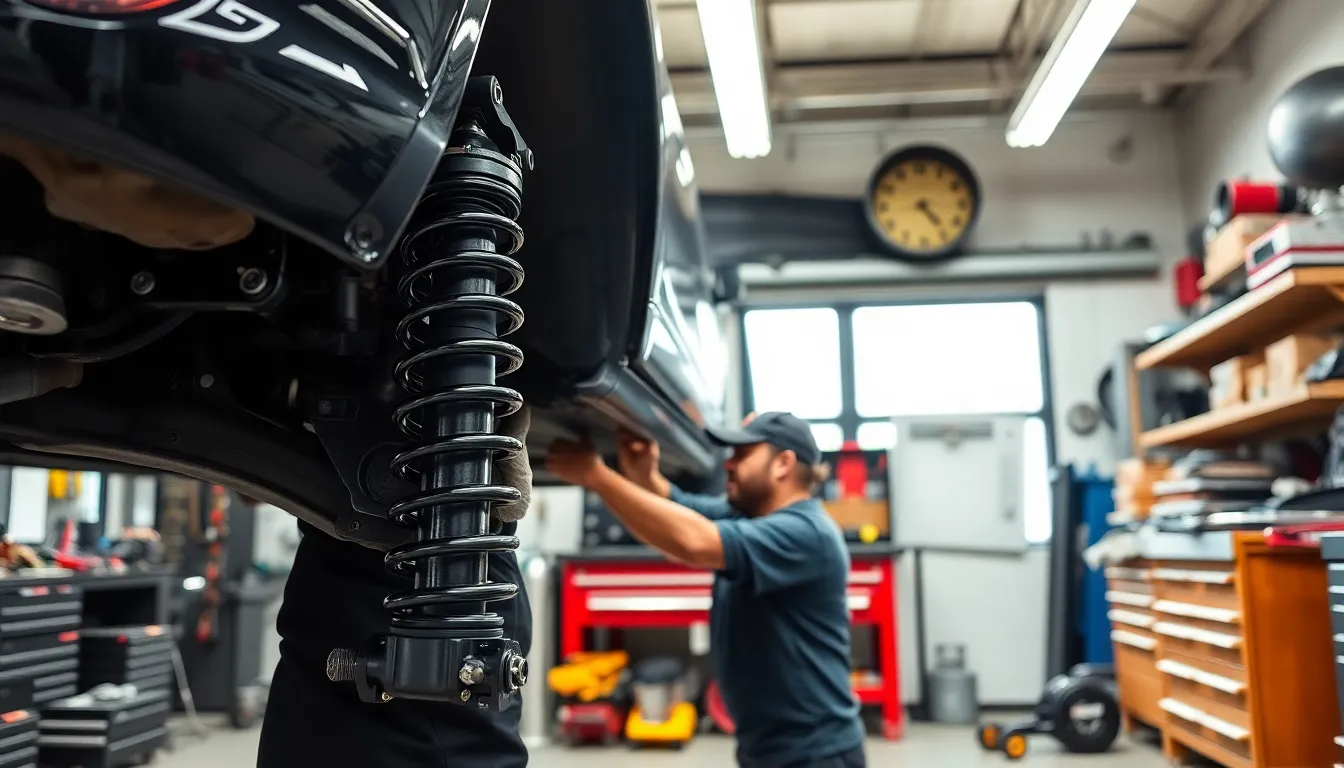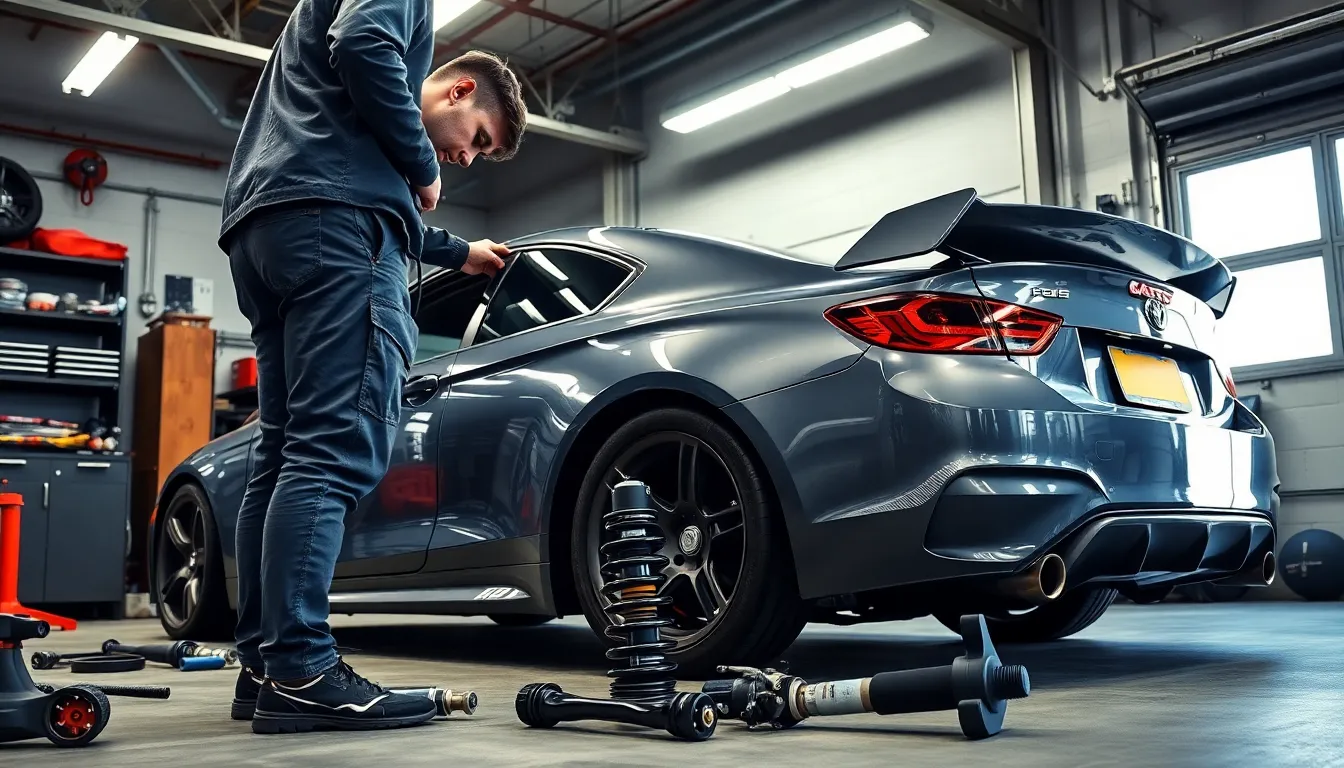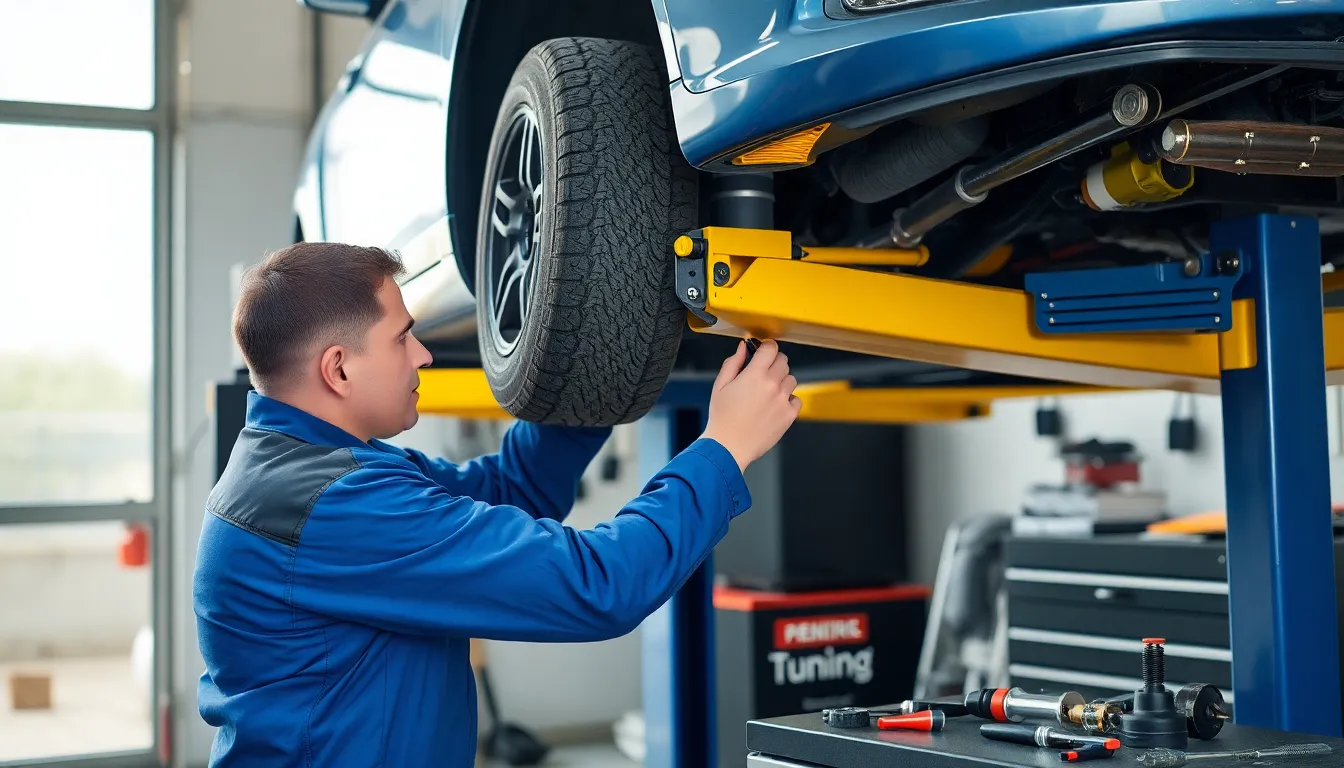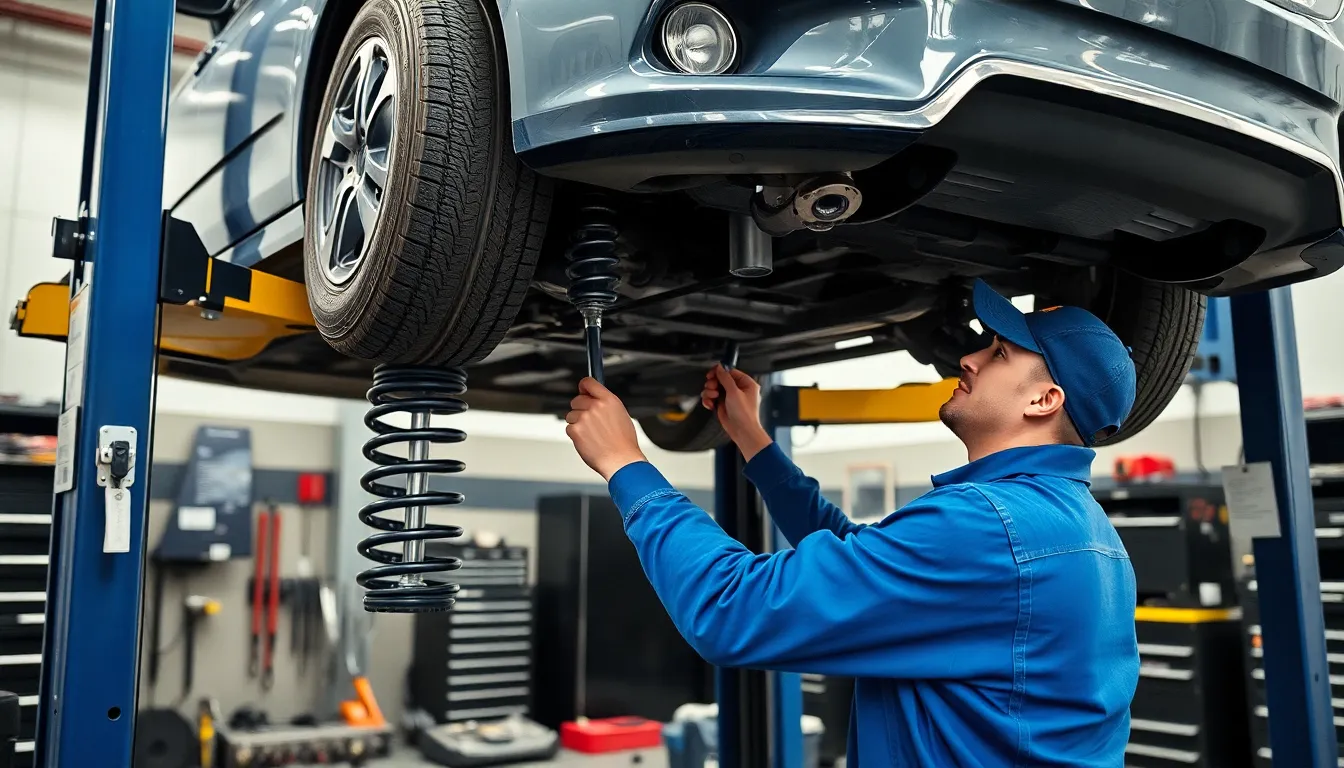Your car’s suspension system determines everything – from how smoothly you glide over bumps to how confidently you tackle sharp corners. We’ve all felt that moment when our vehicle just doesn’t handle the way we want it to, whether it’s excessive body roll during turns or that unsettling bounce after hitting a pothole.
Suspension tuning transforms your driving experience by optimizing your car’s handling characteristics to match your exact needs and driving style. Whether you’re seeking improved comfort for daily commuting or enhanced performance for weekend track days, proper suspension setup makes all the difference.
We’ll guide you through the essential aspects of suspension tuning that every car enthusiast should understand. From adjusting ride height and damping settings to selecting the right springs and anti-roll bars, you’ll discover how small modifications can deliver dramatic improvements in your vehicle’s behavior and your overall driving satisfaction.
What Is Car Suspension Tuning
Car suspension tuning involves adjusting and modifying the components that control how your vehicle handles bumps, corners, and road surfaces. We define this process as the systematic alteration of springs, dampers, anti-roll bars, and other suspension elements to achieve exact performance characteristics.
The practice encompasses both mechanical adjustments and component replacements to optimize vehicle dynamics. Suspension tuning affects three primary areas: ride quality, handling precision, and vehicle stability during acceleration and braking. Most enthusiasts focus on achieving a balance between comfort and performance that matches their driving style.
Common tuning modifications include adjusting coilover dampers, replacing factory springs with performance alternatives, and installing adjustable anti-roll bars. These changes allow drivers to fine-tune their vehicle’s response to different driving conditions. Track-focused setups typically prioritize stiffness and responsiveness while street configurations emphasize comfort and compliance.
Professional tuners often start with baseline measurements of suspension geometry, spring rates, and damping characteristics before making modifications. This data-driven approach ensures that each adjustment produces measurable improvements in the desired performance metrics. The tuning process typically involves multiple iterations of testing and adjustment to achieve optimal results.
Modern suspension systems offer various adjustment points including ride height, compression damping, rebound damping, and preload settings. Electronic systems add complexity by allowing real-time adjustments through drive modes and adaptive algorithms. These advanced systems can automatically adapt suspension characteristics based on road conditions and driving inputs.
Types of Suspension Components You Can Tune

We can modify several key suspension components to transform your vehicle’s ride characteristics and handling performance. Each component plays a distinct role in how your car responds to road surfaces and driving inputs.
Springs and Coilovers
Springs form the foundation of your suspension system by supporting vehicle weight and absorbing road shocks. Coilovers combine coil springs with shock absorbers in a single unit, offering adjustable spring preload and ride height capabilities that enable precise tuning for different driving scenarios. Adjusting spring rates determines how your car responds to bumps and corners, with stiffer rates providing better handling at the expense of comfort. We find that coilover systems deliver the most comprehensive tuning options, allowing for height adjustments ranging from 1-3 inches in most applications. Factory spring rates typically range from 150-300 pounds per inch for front springs and 200-400 pounds per inch for rear springs, while performance alternatives can exceed 500 pounds per inch for track applications.
Shock Absorbers and Dampers
Shock absorbers control the oscillations created by springs, managing ride quality and wheel movement throughout suspension travel. Tunable shock absorbers feature adjustable compression and rebound rates that enhance stability and reduce excessive bounce after impact with road irregularities. Dampers can be configured for exact driving conditions, with adjustment ranges typically offering 16-32 distinct settings for compression and rebound damping. We observe that properly tuned dampers eliminate the floating sensation common with worn factory units while maintaining wheel contact with road surfaces. Performance dampers often include separate high-speed and low-speed compression circuits that respond differently to various impact velocities.
Sway Bars and Anti-Roll Bars
Sway bars connect the left and right sides of your suspension system to reduce body roll during cornering maneuvers. Tuning involves modifying bar diameter or stiffness characteristics, which directly affects how much your vehicle leans in turns. Larger diameter bars decrease roll angles and improve handling precision, with typical aftermarket bars ranging from 22mm to 32mm compared to factory units measuring 18mm to 24mm. We recommend starting with rear sway bar upgrades as they provide noticeable improvements without compromising ride quality. Adjustable end links allow for fine-tuning of bar effectiveness and can alter handling balance between understeer and oversteer characteristics.
Bushings and Mounts
Bushings serve as rubber or polyurethane cushions at suspension connection points that absorb vibrations while allowing controlled component movement. Upgrading bushings to stiffer materials reduces deflection and improves precision and feedback during aggressive driving situations. Performance bushings typically use polyurethane compounds with durometer ratings between 80A and 95A compared to factory rubber bushings measuring 60A to 70A. We notice that stiffer bushings transmit more road noise and vibration into the cabin while delivering enhanced steering response and suspension control. Strategic bushing replacement at control arm pivot points and shock mounts yields the most important improvements in suspension communication and handling accuracy.
Benefits of Suspension Tuning for Your Car

Suspension tuning transforms your vehicle’s handling characteristics by optimizing tire contact with the road surface. Enhanced grip translates directly into improved cornering ability and overall vehicle control during aggressive driving maneuvers. Body roll reduction around curves and sharp turns makes your car more responsive to steering inputs.
Significantly Improved Safety Performance
Well-tuned suspension systems maintain even vehicle height and proper balance across all four corners. Effective tire grip ensures consistent braking performance and vehicle stability in emergency situations. Regular suspension adjustments prevent unexpected component failures that could result in loss of control while driving.
Measurable Cost Reductions
Properly aligned suspension components prevent uneven tire wear patterns and premature component degradation. Maintained fuel efficiency increases by up to 7% with correctly tuned suspension systems. Annual gas savings exceed $150 for most drivers when suspension geometry remains optimized throughout the year.
Enhanced Ride Comfort
Tuned suspension absorbs road irregularities more effectively than factory configurations. Reduced harshness and vibrations create a more pleasant driving experience during daily commutes. Driver fatigue decreases significantly on longer trips when suspension components work in harmony.
Extended Component Longevity
Proper suspension tuning minimizes wear on tires, shock absorbers, and related components. Balanced load distribution across suspension elements extends their operational lifespan considerably. Professional tuning services customize your vehicle’s performance characteristics to match exact driving conditions and personal preferences.
Popular Suspension Tuning Methods

Several proven approaches exist for modifying suspension characteristics to achieve optimal performance and handling. Each method offers distinct advantages depending on your exact goals and driving requirements.
Lowering Springs Installation
Lowering springs reduce vehicle ride height while improving aerodynamics and decreasing body roll during cornering. These springs typically increase the spring rate compared to factory components, resulting in a firmer ride quality but enhanced handling precision. Installation involves replacing stock springs with aftermarket units that position the vehicle closer to the ground, reducing the center of gravity for improved stability. Many enthusiasts choose progressive rate springs that offer softer initial compression for comfort while providing increased stiffness under load for performance driving.
Coilover System Upgrades
Coilover systems combine springs and dampers in a single adjustable unit, offering precise control over both ride height and spring rate settings. These systems allow fine-tuning of suspension stiffness to accommodate different driving styles, from daily commuting to track performance. Adjustable perches enable height modifications without changing spring preload, maintaining optimal suspension geometry. Quality coilover setups feature separate adjustment mechanisms for compression and rebound damping, providing comprehensive tuning capabilities for various road conditions and performance requirements.
Adjustable Damper Setup
Dampers control spring oscillations and significantly affect how vehicles handle bumps and navigate corners. Adjustable dampers feature multiple settings for both rebound and compression rates, enabling optimization of the car’s response to different road surfaces and driving scenarios. External adjustment knobs allow real-time modifications without disassembly, making it simple to adapt suspension characteristics for exact conditions. These systems typically offer 16 to 32 distinct adjustment positions, providing granular control over damping forces to achieve the perfect balance between comfort and performance.
Choosing the Right Suspension Setup for Your Driving Style

Different driving environments require distinct suspension configurations to achieve optimal performance and comfort. Understanding your primary use case helps us determine the most effective tuning approach for your vehicle.
Street Performance Tuning
Street performance tuning focuses on achieving balance between handling and comfort for spirited driving on public roads. Spring rates require careful adjustment to provide sufficient support without compromising ride quality for daily use. Damping systems need fine tuning on shock absorbers to control oscillations and improve handling characteristics during cornering maneuvers.
Camber and toe settings enhance tire contact with the road surface, improving both traction and stability. Moderate spring rates typically range from 20-40% stiffer than stock settings while maintaining acceptable comfort levels. Adjustable dampers allow us to dial in compression and rebound rates that complement the increased spring rates effectively.
Anti roll bars benefit from modest upgrades to reduce body roll without creating harsh ride characteristics on uneven surfaces. Performance oriented street setups prioritize responsiveness while preserving the compliance necessary for varied road conditions and everyday driving scenarios.
Track Day Optimization
Track day optimization maximizes grip and stability at high speeds through aggressive suspension modifications. Stiffer springs reduce body roll and enhance cornering capabilities, with rates often 50-100% higher than stock specifications. Racing environments demand this increased stiffness to maintain proper tire contact patch geometry during high load cornering.
Adjustable damping systems provide fine tuning capabilities based on exact track conditions and surface characteristics. Compression and rebound rates require precise calibration to match the increased spring rates and maintain tire contact through elevation changes. Professional track setups often use 3-way adjustable dampers for maximum tunability.
Camber settings become more aggressive, ranging from -2.0 to -3.5 degrees depending on tire specifications and track layout requirements. Anti roll bars increase in stiffness significantly to minimize body roll during high speed transitions. Ride height drops to lower the center of gravity while maintaining adequate ground clearance for track safety requirements.
Daily Driver Comfort Balance
Daily driver comfort balance prioritizes smooth ride quality while ensuring sufficient handling capabilities for normal driving conditions. Softer springs improve ride comfort by absorbing road irregularities more effectively than performance oriented setups. Spring rates typically remain within 10-20% of stock specifications to maintain comfort while providing modest handling improvements.
Balanced damping rates control body oscillations without creating harsh impacts over road imperfections. Compression and rebound settings focus on managing weight transfer smoothly during acceleration, braking, and gentle cornering maneuvers. Factory damper characteristics often provide the best foundation for comfort oriented applications.
Camber and toe settings minimize tire wear while improving stability during highway driving and parking maneuvers. Conservative alignment specifications extend tire life and reduce maintenance costs. Anti roll bars remain close to stock specifications or receive mild upgrades to control body roll without transmitting excessive road harshness to the cabin.
Professional vs DIY Suspension Tuning

We face a critical decision when optimizing suspension performance: choosing between professional services and DIY approaches. Each method offers distinct advantages that align with different budgets, skill levels, and performance goals.
Professional Suspension Tuning
Professional suspension tuning delivers precise adjustments through specialized equipment and trained technicians who optimize suspension components systematically. Technicians use advanced alignment machines and calibrated tools to achieve manufacturer-specified settings with exceptional accuracy. This method ensures optimal alignment settings, enhanced handling characteristics, and improved ride comfort through comprehensive analysis of suspension geometry.
Professional services identify worn components during the tuning process and address underlying issues that affect performance. Technicians can detect problems like worn bushings, damaged springs, or compromised dampers that DIY enthusiasts might overlook. High-performance vehicles and complex suspension systems particularly benefit from professional expertise since these setups require precise adjustments to multiple interconnected components.
The professional approach offers several measurable advantages:
- Precision alignment within manufacturer specifications
- Advanced diagnostic capabilities for identifying worn components
- Specialized equipment for complex geometry adjustments
- Warranty protection on performed services
- Time efficiency through streamlined processes
DIY Suspension Tuning
DIY suspension tuning provides cost-effective access to basic adjustments while building mechanical knowledge about suspension systems. Enthusiasts use fundamental tools like string, chalk, and tape measures to perform alignment measurements and component adjustments. This approach works effectively for simple modifications like spring changes, basic toe adjustments, and damper replacements.
DIY methods offer important cost savings compared to professional services, especially for enthusiasts performing multiple rounds of testing and refinement. Car owners develop deeper understanding of their vehicle’s suspension behavior through hands-on experience with component interactions. Basic adjustments like ride height changes, spring preload settings, and anti-roll bar adjustments remain accessible to motivated DIY tuners.
But, DIY tuning faces inherent limitations in precision and scope:
- Limited tool accuracy compared to professional equipment
- Difficulty achieving complex camber and caster adjustments
- Time investment for learning proper techniques
- Potential for errors without professional oversight
- Safety considerations during component removal and installation
Key Performance Differences
Professional tuning achieves precision levels that DIY methods struggle to match, particularly for critical alignment angles like camber, caster, and toe settings. Professional equipment measures these angles within fractions of degrees, while DIY tools typically provide rougher approximations. This precision difference becomes crucial for performance applications where small adjustments create important handling improvements.
Cost considerations vary significantly between approaches, with professional services requiring higher upfront investment but potentially saving money through accurate first-time adjustments. DIY tuning spreads costs across tool purchases and multiple adjustment sessions, making it more accessible for budget-conscious enthusiasts willing to invest time learning proper techniques.
We recommend professional tuning for complex suspension systems, precision-critical applications, and situations where warranty protection matters most. DIY approaches work best for learning experiences, budget-constrained projects, and enthusiasts comfortable with iterative testing processes.
Common Suspension Tuning Mistakes to Avoid

Multiple suspension changes made simultaneously create confusion when diagnosing performance issues. We recommend adjusting one component at a time to isolate exact effects on vehicle behavior. This systematic approach allows us to identify which modifications produce desired improvements versus those that create unwanted side effects.
Torque specifications during installation often get overlooked by enthusiasts replacing suspension components. Control arms and bushings require final torque application while the suspension bears load to prevent premature failure. We emphasize loading the suspension to its normal ride height before applying manufacturer-specified torque values.
Tire pressure monitoring and wear pattern inspection reveal critical suspension alignment issues. Uneven tire wear patterns indicate potential problems with camber angles, toe settings, or worn suspension components. We check tire pressures weekly and inspect wear patterns monthly to maintain optimal contact patch performance.
Overstiff suspension setups reduce tire contact with road surfaces during cornering and braking events. Excessive spring rates and damping forces limit suspension travel, causing tires to lose grip when encountering road irregularities. We balance spring rates with appropriate damping settings to maintain consistent tire contact.
| Suspension Issue | Front Adjustment | Rear Adjustment | Expected Result |
|---|---|---|---|
| Understeer | Soften front shocks | Maintain rear settings | Improved front grip |
| Oversteer | Maintain front settings | Stiffen rear shocks | Enhanced rear stability |
| Excessive stiffness | Reduce spring rates | Adjust damping accordingly | Better road compliance |
Understanding understeer and oversteer characteristics helps us make targeted adjustments for exact handling behaviors. Front tire traction loss creates understeer conditions that respond to softer front shock settings. Rear tire traction loss produces oversteer situations that benefit from increased rear shock stiffness. We monitor vehicle behavior during controlled testing to identify these characteristics accurately.
Baseline measurements before modifications provide reference points for evaluating suspension changes. Recording ride heights, alignment specifications, and handling characteristics creates a foundation for systematic improvements. We document each adjustment with corresponding performance notes to track progress throughout the tuning process.
Cost Considerations for Suspension Modifications

Suspension modifications present varying financial investments depending on the scope and complexity of your tuning goals. Basic repairs and minor upgrades typically cost between $200 to $400, covering essential maintenance like replacing worn bushings, adjusting shock absorbers, or correcting alignment issues.
Budget-Friendly Suspension Updates
Spring replacement represents one of the most common modifications we encounter in suspension tuning projects. Parts alone range from $200 to $400, with labor charges adding $50 to $150 depending on vehicle complexity and local mechanic rates. These modifications deliver noticeable improvements in handling characteristics without breaking your budget.
Performance struts and shocks fall into the moderate to high cost category but provide enhanced responsiveness and terrain comfort. While these components cost more than basic replacements, they often eliminate the need for frequent adjustments and deliver consistent performance over extended periods.
Premium Suspension System Investments
Major suspension overhauls involving struts, control arms, sway bars, or complete system rebuilds range from $1,000 to $5,000 or more. Vehicle model complexity, part quality selection, and installation difficulty directly influence these costs.
Air suspension systems command premium pricing between $500 and $2,000, with some installations exceeding this range based on vehicle type and geographic location. These systems offer real-time height adjustment and exceptional comfort but require careful consideration of long-term maintenance expenses.
Adjustable coilovers represent the highest investment category, providing precise height and damping control for customized handling characteristics. Expert installation and tuning expertise become essential with these systems, adding to the overall project cost.
Performance vs Investment Analysis
| Modification Type | Cost Range | Performance Benefits | Maintenance Considerations |
|---|---|---|---|
| Lowering Kits | Moderate | Improved aerodynamics, enhanced cornering | Increased ground clearance concerns |
| Lift Kits | Moderate to High | Better off-road capability, larger tire accommodation | Altered center of gravity, increased wear patterns |
| Adjustable Coilovers | High | Customizable height and damping settings | Regular adjustment requirements, specialized knowledge needed |
| Air Suspension | $500-$2,000+ | Ever-changing height control, superior comfort | Potential leak issues, complex maintenance procedures |
Planning your suspension budget requires balancing immediate performance goals with long-term ownership costs. Quality components often justify higher upfront investments through reduced maintenance frequency and extended service life.
Installation complexity significantly affects labor costs across all modification types. Simple spring replacements take fewer shop hours compared to complete coilover installations requiring specialized alignment equipment and expertise.
Conclusion
We’ve explored the comprehensive industry of suspension tuning and discovered how these modifications can transform your driving experience. From basic spring replacements to sophisticated coilover systems each adjustment offers unique benefits that align with your exact driving goals.
The investment in suspension tuning pays dividends through improved handling enhanced safety and reduced long-term maintenance costs. Whether you’re seeking track-day performance or daily driving comfort the right suspension setup delivers measurable improvements in vehicle dynamics.
Remember that successful suspension tuning requires patience methodical adjustments and often professional expertise. Start with your exact needs assess your budget carefully and don’t hesitate to seek professional guidance for complex modifications.
Your vehicle’s suspension system holds incredible potential for customization. With the knowledge and strategies we’ve shared you’re now equipped to make informed decisions that’ll elevate your driving experience to new heights.
Frequently Asked Questions
What is car suspension tuning?
Car suspension tuning involves adjusting and modifying components like springs, dampers, anti-roll bars, and other suspension elements to achieve specific performance characteristics. This process systematically alters how your vehicle handles bumps, corners, and road surfaces. The goal is to optimize ride quality, handling precision, and vehicle stability during acceleration and braking to match your driving style and preferences.
Which suspension components can be tuned for better performance?
The main tunable suspension components include springs and coilovers for weight support and shock absorption, shock absorbers and dampers for managing oscillations, and sway bars or anti-roll bars for reducing body roll during cornering. Additionally, upgrading bushings and mounts can improve precision and feedback. Each component offers different adjustment points to fine-tune your vehicle’s handling characteristics.
What are the main benefits of suspension tuning?
Suspension tuning enhances vehicle handling by optimizing tire contact with the road, improves safety through better balance and grip, and reduces costs via decreased tire wear and increased fuel efficiency. It also enhances ride comfort by absorbing road irregularities, reduces driver fatigue on longer trips, and extends component longevity through balanced load distribution and minimized wear.
What are the most popular suspension tuning methods?
The most popular methods include installing lowering springs to reduce ride height and improve handling precision, upgrading to coilover systems for adjustable ride height and spring rate control, and installing adjustable damper setups for real-time modifications. These approaches allow for precise control over your vehicle’s response to various road conditions and driving scenarios.
How do I choose the right suspension setup for my needs?
Choose based on your driving style and environment. Street performance tuning balances handling and comfort for spirited driving. Track day optimization focuses on maximum grip and stability through aggressive modifications. Daily driver comfort prioritizes smooth ride quality while maintaining adequate handling. Consider your primary use case when selecting spring rates, damping systems, and alignment settings.
Should I do suspension tuning myself or hire a professional?
Professional tuning offers precise adjustments through specialized equipment and trained technicians, making it ideal for high-performance vehicles and complex systems. DIY tuning is cost-effective for basic adjustments and learning about suspension systems but has precision limitations and safety concerns. Choose professional tuning for complex setups and critical applications, DIY for budget-conscious basic modifications.
What common mistakes should I avoid when tuning suspension?
Avoid making multiple changes simultaneously, as this makes it difficult to understand each adjustment’s effect. Don’t overlook torque specifications during installation or neglect tire pressure monitoring. Always isolate adjustments to track their impact on vehicle behavior. Take baseline measurements before modifications and understand understeer and oversteer characteristics to make targeted adjustments effectively.
How much does suspension tuning typically cost?
Costs vary significantly based on goals and complexity. Basic repairs and minor upgrades range from $200-$400. Performance struts and shocks fall into moderate to high cost categories. Major overhauls can cost $1,000-$5,000 or more. Budget-friendly updates like spring replacements are available, while premium systems like air suspension and adjustable coilovers command higher prices.

